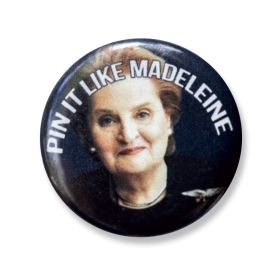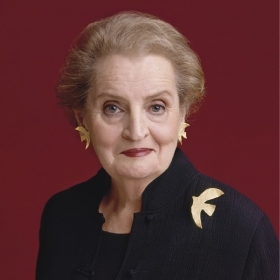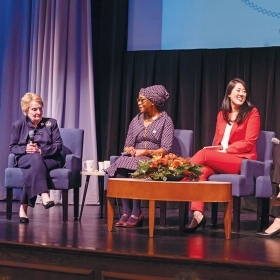One of the many times Madeleine Korbel Albright ’59 returned to Wellesley was ahead of the opening of the traveling exhibit Read My Pins: Stories from a Diplomat’s Jewel Box at the Davis Museum in...

One of the many times Madeleine Korbel Albright ’59 returned to Wellesley was ahead of the opening of the traveling exhibit Read My Pins: Stories from a Diplomat’s Jewel Box at the Davis Museum in 2014. During a conversation with then-President H. Kim Bottomly, Albright explained how her pins became a part of her diplomat’s toolbox.
As U.S. ambassador to the United Nations, Albright had strongly criticized Saddam Hussein, and his poet-in-residence responded by calling her “an unparalleled serpent.” In 1997, when meeting with Iraqi officials, she decided to make a statement by wearing a snake pin, which the press noticed right away. (There is a photo of this iconic pin here.)
“I thought, ‘Well, this is fun,’” Albright told the packed audience in Alumnae Hall. “So I went out … and I bought a lot of costume jewelry. Easy to do around New York. … Finally, the other ambassadors noticed this, and they were always trying to figure out what the agenda for the day was going to be, and I said, ‘Well, read my pins.’”
I’ve always enjoyed Albright’s pins, which revealed her wit and humanity. Read My Pins was at the Davis during my 15th reunion, Albright’s 55th. That year, I helped decorate my class’s Saturday-night dinner tent and scattered the tables with pins I made featuring a photo of the former secretary of state with the statement, “Pin it like Madeleine” (pictured above).
I wonder if Albright created an exhibit because she was running out of storage space at home—everyone gave her pins, including the College. The Alumnae Association gave her a gold oak leaf pin when she received the Alumnae Achievement Award in 1992, and in 2010, after the creation of the Madeleine Korbel Albright Institute for Global Affairs, the College gave her a pin of the globe. (You can see a photo of this pin here.) As the institute wraps up at the end of each January, the fellows receive their own globe pins, modeled after Albright’s.
When Albright’s death was announced on March 23, many Wellesley alums expressed their sorrow on social media, including some of the 500 Albright fellows out in the world. From Tunis, Elena Scott-Kakures ’15 (@EScottKakures), a fellow who is now a program advisor at the U.S. Department of State, tweeted that she was glad to have her Albright Institute pin with her on her trip. “Grateful to have spent even a small amount of time with @madeleine. A reminder to practice strong, dedicated diplomacy and support education for women and girls everywhere,” she said. For “The Mentor,” Catherine O’Neill Grace, senior associate editor of this magazine, spoke with seven other fellows about the impact Albright and the institute have had on their lives.
In “The Negotiator,” Carla Anne Robbins ’74 considered the many challenges Albright faced during her career. I was maddened, but not surprised, to learn about the hostility and sexism Albright encountered. During the 2014 talk in Alumnae Hall, a student asked Albright if she had ever felt intimidated. Albright replied, “Often, I’ve felt very intimidated in meetings where I was the only woman. … I wanted to say something, and then I’d think, ‘Well, that’s going to sound stupid,’ so I don’t say it, and then some man says it, and everybody thinks it’s brilliant.” When she began teaching, she wanted to teach her students “how to interrupt,” which was something she had to learn herself.
After this year’s commencement, two wonderful longtime magazine student workers, Grace Ramsdell ’22 and Maddie Paoletti ’22, headed out into the world. Grace, a writer and visual artist, is pursuing an internship at the Emerald Necklace Conservancy in Boston; Maddie is beginning her Ph.D. at MIT in the Department of Earth, Atmospheric, and Planetary Sciences. I have no doubt they’ll be making their brilliant voices heard, making sure that others are added to the conversation, and interrupting when necessary. Before they graduated, I made them each a miniature version of the magazine with themselves on the cover—pins, of course.


